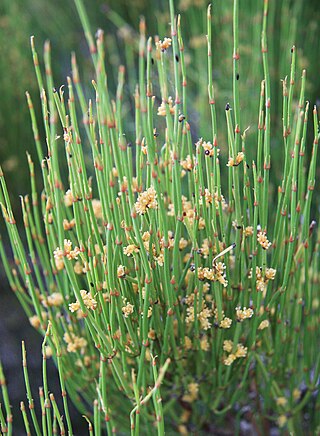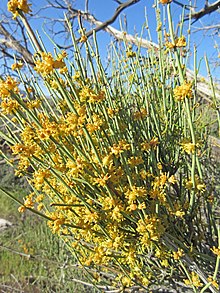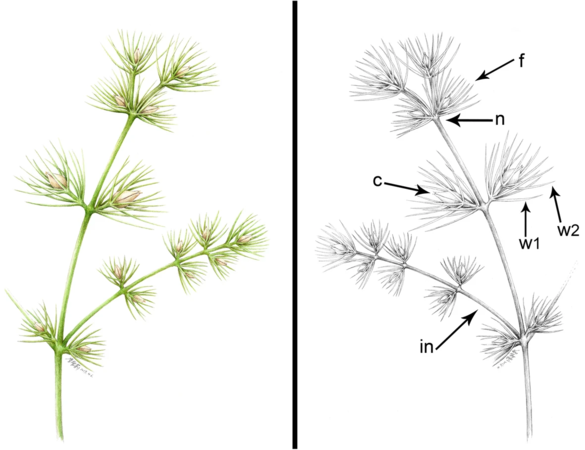
Gnetophyta is a division of plants, grouped within the gymnosperms, that consists of some 70 species across the three relict genera: Gnetum, Welwitschia, and Ephedra. The earliest unambiguous records of the group date to the Jurassic, and they achieved their highest diversity during the Early Cretaceous. The primary difference between gnetophytes and other gymnosperms is the presence of vessel elements, a system of small tubes (xylem) that transport water within the plant, similar to those found in flowering plants. Because of this, gnetophytes were once thought to be the closest gymnosperm relatives to flowering plants, but more recent molecular studies have brought this hypothesis into question, with many recent phylogenies finding them to be nested within the conifers.
The Yixian Formation is a geological formation in Jinzhou, Liaoning, People's Republic of China, that spans the late Barremian and early Aptian stages of the Early Cretaceous. It is known for its exquisitely preserved fossils, and is mainly composed of basalts interspersed with siliciclastic sediments.

Snakeflies are a group of predatory insects comprising the order Raphidioptera with two extant families: Raphidiidae and Inocelliidae, consisting of roughly 260 species. In the past, the group had a much wider distribution than it does now; snakeflies are found in temperate regions worldwide but are absent from the tropics and the Southern Hemisphere. Recognisable representatives of the group first appeared during the Early Jurassic. They are a relict group, having reached their apex of diversity during the Cretaceous before undergoing substantial decline.

Jinzhousaurus is a genus of hadrosauroid dinosaur of the Early Cretaceous of China. The type species is Jinzhousaurus yangi. The generic name refers to the town Jinzhou. The specific name honours Yang Zhongjian as the founder of Chinese paleontology. It was first described by Wang Xiao-lin and Xu Xing in 2001.

Liaoningosaurus is an unusual genus of basal ankylosaurid dinosaur from the Liaoning Province, China that lived during the Early Cretaceous in what is now the Yixian and Jiufotang Formation. The type and only species, Liaoningosaurus paradoxus, is known from more than 20 specimens, with some representing juveniles. It was named in 2001 by Xu, Wang and You.

Ephedra is a genus of gymnosperm shrubs. The various species of Ephedra are widespread in many arid regions of the world, ranging across southwestern North America, southern Europe, northern Africa, southwest and central Asia, northern China and western South America. It is the only extant genus in its family, Ephedraceae, and order, Ephedrales, and one of the three living members of the division Gnetophyta alongside Gnetum and Welwitschia.

Pelecinidae is a family of parasitic wasps in the superfamily Proctotrupoidea. It contains only one living genus, Pelecinus, with three species known from the Americas. The earliest fossil species are known from the Jurassic, and the group was highly diverse during the Cretaceous. Members of Pelecinus are parasitic on larval beetles, flies, green lacewings, and sawflies.

Eosipterus is an extinct genus of ctenochasmatid pterosaur from the Early Cretaceous period of Liaoning, China. Fossil remains of Eosipterus dated back to the Aptian stage of the Early Cretaceous, 125 million years ago.

Archaeamphora longicervia is a fossil plant species, the only member of the hypothetical genus Archaeamphora. Fossil material assigned to this taxon originates from the Yixian Formation of northeastern China, dated to the Early Cretaceous.

Archaefructus is an extinct genus of herbaceous aquatic seed plants with three known species. Fossil material assigned to this genus originates from the Yixian Formation in northeastern China, originally dated as late Jurassic but now understood to be approximately 125 million years old, or early Cretaceous in age. Even with its revised age, Archaefructus has been proposed to be one of the earliest known genera of flowering plants.

The Jehol Biota includes all the living organisms – the ecosystem – of northeastern China between 133 and 120 million years ago. This is the Lower Cretaceous ecosystem which left fossils in the Yixian Formation and Jiufotang Formation. These deposits are composed of layers of tephra and sediment. It is also believed to have left fossils in the Sinuiju series of North Korea. The ecosystem in the Lower Cretaceous was dominated by wetlands and numerous lakes. Rainfall was seasonal, alternating between semiarid and mesic conditions. The climate was temperate. The Jehol ecosystem was interrupted periodically by ash eruptions from volcanoes to the west. The word "Jehol" is a historical transcription of the former Rehe Province.
The Jiufotang Formation is an Early Cretaceous geological formation in Chaoyang, Liaoning which has yielded fossils of feathered dinosaurs, primitive birds, pterosaurs, and other organisms. It is a member of the Jehol group. The exact age of the Jiufotang has been debated for years, with estimates ranging from the Late Jurassic to the Early Cretaceous. New uranium-lead dates reveal the formation is deposited in the Aptian stage of the Early Cretaceous. Fossils of Microraptor and Jeholornis are from the Jiufotang.

The Yixian Formation is a geological formation in Jinzhou, Liaoning, People's Republic of China, that spans about 1.6 million years during the early Cretaceous period. It is known for its fossils, listed below.
The Haifanggou Formation, also known as the Jiulongshan Formation, is a fossil-bearing rock deposit located near Daohugou village of Ningcheng County, in Inner Mongolia, northeastern China.

Bolong is a genus of iguanodontian dinosaur known from the Early Cretaceous-age Yixian Formation of western Liaoning Province, China. It lived about 125 million years ago in the earliest Aptian.

Moganopterus is an extinct genus of ctenochasmatid pterosaur from the Early Cretaceous of western Liaoning Province, China.
This article records new taxa of fossil plants that are scheduled to be described during the year 2020, as well as other significant discoveries and events related to paleobotany that are scheduled to occur in the year 2020.
This list of 2013 in paleobotany records new fossil plant taxa that were described during 2013, as well as other significant discoveries and events related to paleobotany that occurred in the year.

Umaltolepis is an extinct genus of seed plant, known from the Early Jurassic to Early Cretaceous of Asia. Within the form classification system used within paleobotany, it refers to the seed-bearing reproductive structures, which grew on woody plants with strap-shaped Ginkgo-like leaves assigned to the genus Pseudotorellia.

Oregramma is a genus of "butterfly mimicking" lacewing in the extinct family Kalligrammatidae. Fossils of this genus have been found in the Early Cretaceous Yixian Formation of China. It likely fed on pollen and plant juices, unlike modern lacewings, most of which are carnivorous.




















